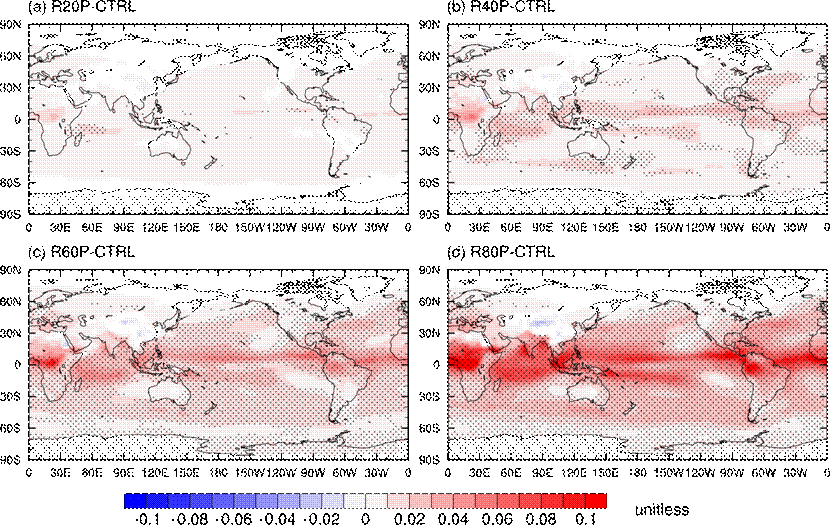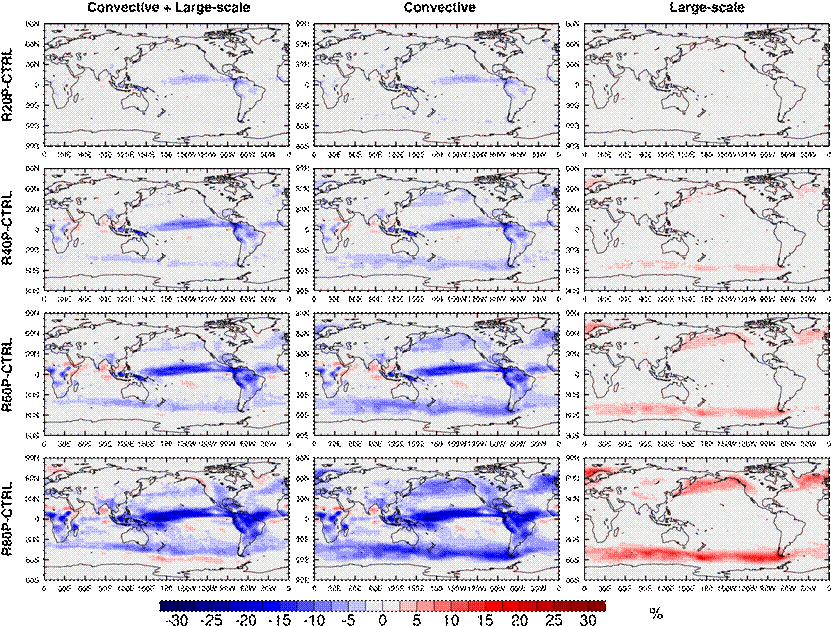Recently, the Research Group of Associate Professor Wang Yong of the Department of Earth System Science (DESS), Tsinghua University has designed a resolution scale-aware convection parameterization scheme to study its impact on aerosol simulation in global climate models (GCMs), and further analyzed the impact mechanism.
The horizontal grid spacing (resolution) of GCM is generally about several hundred kilometers. Because the spatial scale of convective clouds is much smaller than this grid spacing (i.e. subgrid process), GCM cannot directly describe the characteristics and impacts of convective clouds on the grid scale. Therefore, it is necessary to link the subgrid cumulus convection process with grid-scale meteorological elements to indirectly express their characteristics and impacts on grid-scale meteorological elements (i.e. convection parameterization). Consequently, the total precipitation in GCM consists of two parts: one is grid-scale precipitation, and the other is subgrid precipitation formed by a convection parameterization scheme, both of which can wet remove aerosols in the atmosphere.
With the rapid development of computing power, the horizontal grid spacing of GCM becomes finer, which can reach about 10 kilometers or higher. In the context of such grid spacing, convective clouds with larger scale can be analyzed. Therefore, the simulated convective precipitation at high resolution should be reduced compared with that at low resolution, while the grid-scale precipitation should increase correspondingly, with the total precipitation remaining basically unchanged. However, the traditional convection schemes at home and abroad to date fail to simulate the phenomenon that convective precipitation decreases with the increase of resolution. Therefore, it is necessary to develop a convection parameterization scheme (i.e., scale-aware convection parameterization scheme) that automatically identifies the change of resolution and then simulates the corresponding change of convection. Under this scheme, how will aerosol simulation respond when the precipitation changes as mentioned above? Can it stay the same so that the patterns can be coordinated?
With a view to the above problems, the Research Group applied a logic operator in the Zhang-McFarlane convection scheme of the Community Earth System Model at the National Center for Atmospheric Research (NCAR CESM), and improved the adaptability of the convection scheme to the horizontal resolution of the model by controlling the triggering frequency of convection. To eliminate the impact of different resolutions on aerosol simulation, the Research Group applied this scheme to the same model resolution, and designed four groups of sensitivity tests (R20P, R40P, R60P, R80P) in which the convection was reduced by 20%, 40%, 60% and 80% respectively compared to the control experiment (CTRL), to simulate the gradual reduction of convection at different resolutions. The results show that with the decrease of deep convection, compared to the CTRL test, the simulated aerosol optical thickness in the sensitivity test gradually increased almost globally, especially in tropical and subtropical areas (Fig. 1).

Fig. 1 Global distributions of the differences in annual mean aerosol optical depth (AOD) between sensitivity tests and control experiment (CTRL).
In the light of related previous studies of the Research Group, “Impacts of Suppressing Excessive Light Rain on Aerosol Radiative Effects and Health Risks” (Wang, Xia et al., 2021; Wang, Xia, & Zhang, 2021), Fig. 2 presents global distributions of the differences in annual mean aerosol optical depth (AOD) between sensitivity tests and control experiment (CTRL). With the decrease of convection, the frequency of subgrid convective light rain in subtropics and tropics gradually decreases. However, in tropics, no matter how much convection decreases, the frequency of grid-scale light rain increases little. In the latitudes near 50oS and 50oN (where the storm axis is located), with the decrease of convective light rain, the frequency of grid-scale light rain increases significantly. However, the decreasing range of convective light rain frequency is still greater than the increasing range of grid-scale light rain frequency, which demonstrates that the generation efficiency of subgrid convective rain is higher than that of grid-scale light rain, and the decrease of convection reduces the total aerosol wet scavenging, which leads to the increase of aerosol loading.

Fig. 2 Global distributions of the differences in annual mean convective, and large-scale light-rain frequencies between sensitivity tests and control experiment (CTRL), and their combination.
The findings in the research offer important insights for guiding the future development of global climate models. In the development of a resolution scale-aware convective parameterization scheme, under different horizontal resolutions of the model, it is necessary to keep the precipitation in the light rain part stay the same in addition to the total precipitation. This is very important for the model using scale-aware convection parameterization scheme to keep the simulated aerosol load constant at different resolutions. At least one precipitation parameterization scheme with consistent internal physical process may be required to keep the subgrid convection consistent with the generation efficiency of grid-scale light rain.
The above results were published online in a paper titled “Unexpected Changes of Aerosol Burdens With Decreased Convection in the Context of Scale-Aware Convection Schemes” in Geophysical Research Letters on May 27th, 2022.
Xia Wenwen, a 2018 doctoral student of the DESS, Tsinghua University is the first author of the paper and A/Prof. Wang Yong of the DESS, Tsinghua University is the corresponding author of the paper. Cui Zeyu, a doctoral student of the DESS, Tsinghua University, and Wang Bing, Distinguished Visiting Professor of the DESS, Tsinghua University, and Researcher of IAP/CAS are the co-authors of the paper. This research is supported by the Key Research and Development Program of the Ministry of Science and Technology and the National Natural Science Foundation of China.
Paper link:
Xia, W., Wang, Y., Zhang, G. J., Cui, Z., Wang, B., He, Y., & Wang, X. (2022). Unexpected changes of aerosol burdens with decreased convection in the context of scale-aware convection schemes. Geophysical Research Letters, 49, e2022GL099008. https://doi.org/10.1029/2022GL099008
Related research papers of the Research Group:
Wang, Y., Xia, W., Liu, X., Xie, S., Lin, W., Tang, Q., et al. (2021). Disproportionate control on aerosol burden by light rain. Nature Geoscience, 14(2), 72–76. https://doi.org/10.1038/s41561-020-00675-z
Wang, Y., Xia, W., & Zhang, G. J. (2021). What rainfall rates are most important to wet removal of different aerosol types? Atmospheric Chemistry and Physics, 21(22), 16797–16816. https://doi.org/10.5194/acp-21-16797-2021
Wang, Y., Xia, W., Zhang, G. J., Wang, B., & Lin, G. (2022). Impacts of Suppressing Excessive Light Rain on Aerosol Radiative Effects and Health Risks. Journal of Geophysical Research: Atmospheres, 127(9). https://doi.org/10.1029/2021jd036204
Cui, Z., Wang, Y., Zhang, G. J., Yang, M., Liu, J., & Wei, L. (2022). Effects of Improved Simulation of Precipitation on Evapotranspiration and Its Partitioning Over Land. Geophysical Research Letters, 49(5). https://doi.org/10.1029/2021gl097353
Contributed by Wang Yong and Xia Wenwen
Edited by Wang Jiayin
Reviewed by Zhang Qiang